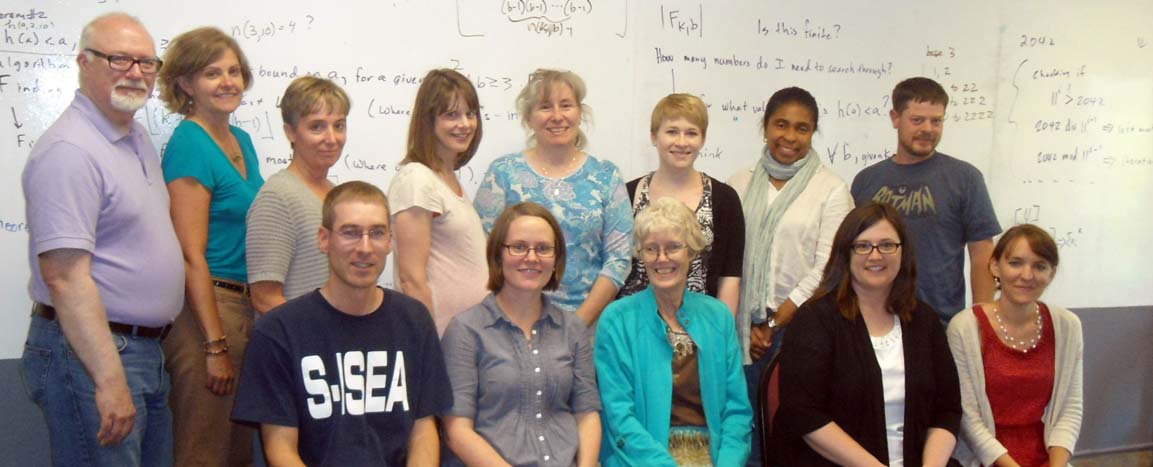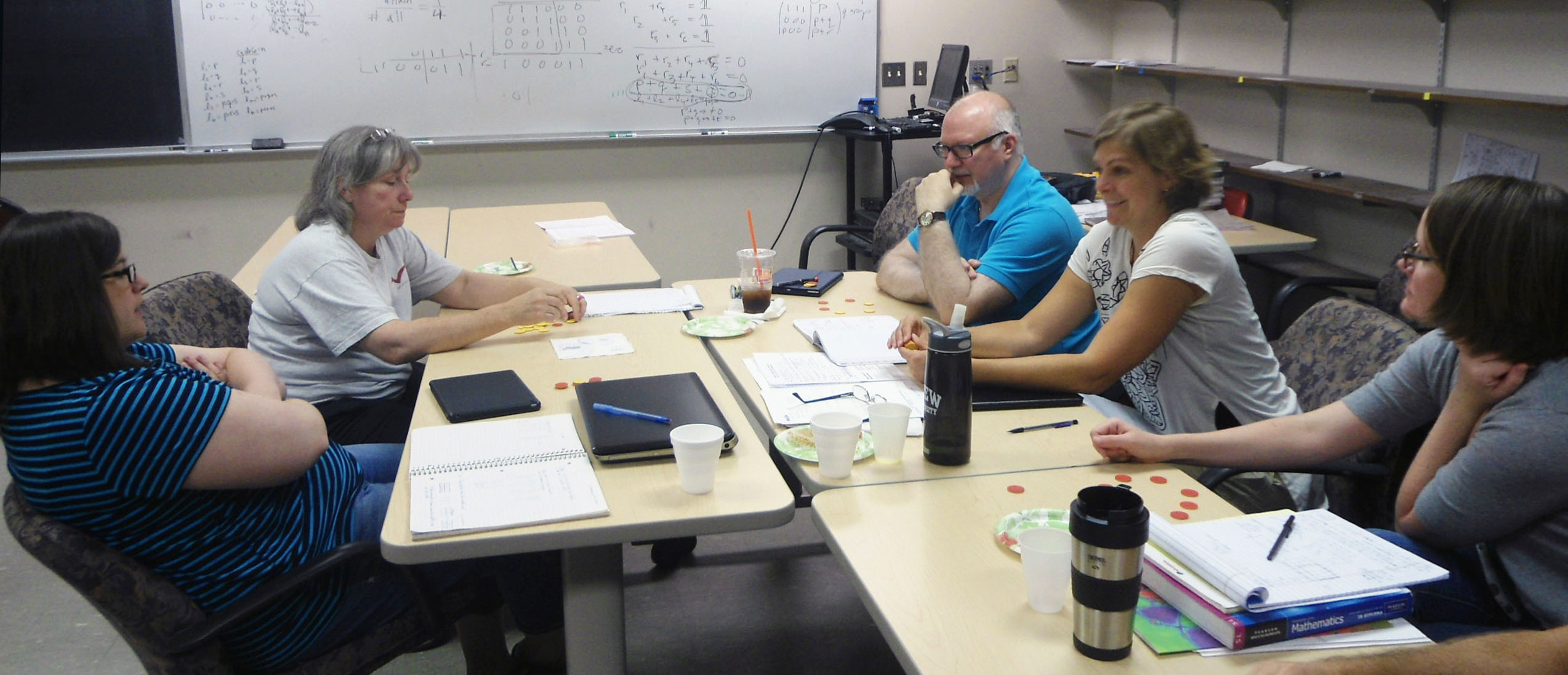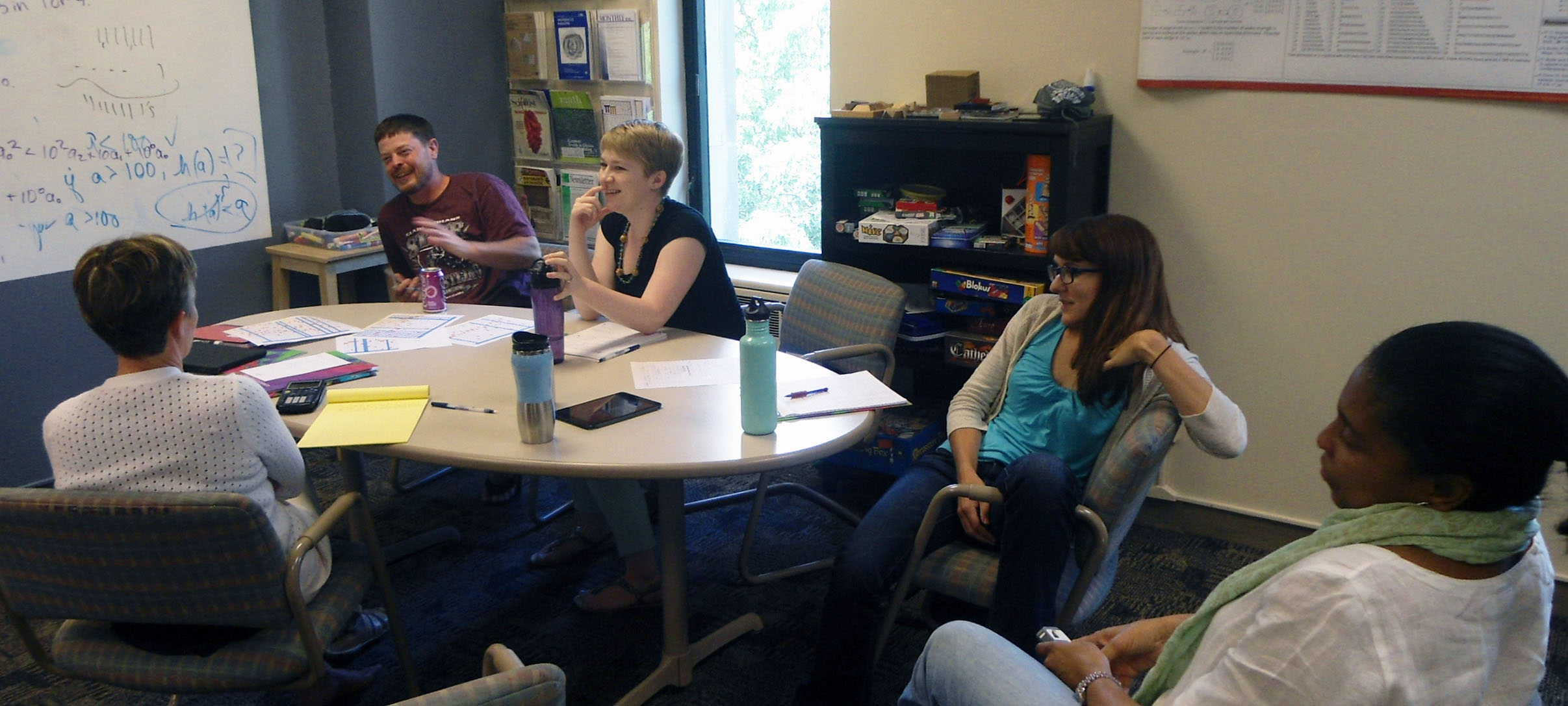Holl Mathematical Discovery Workshop for Teachers 2014
Leslie Hogben, Dio Lewis Holl Chair in Applied Mathematics, Iowa State University
Ulrica Wilson, Associate Professor, Morehouse College

Eight high school teachers
and one community college teacher were invited to the Iowa State
University campus for the Holl Mathematical Discovery for Teachers
Workshop July 14 – 18, 2014. Participating teachers included
- Callie Budden, Metro West Learning Academy
- Brooke Fischels, Ottumwa High School
- Lana Lyddon-Hatten, Central Academy in Des Moines
- Michael Link, Central Academy in Des Moines
- Brian Reece, Central Academy in Des Moines
- Jennifer Parker, Washington Technology Magnet School (St. Paul, MN)
- Courtney Wahlstrom, Indianola High School
- Lynn Yoder, Iowa Mennonite School
- Jacqueline Chalmers, Black Hawk College, IL
The workshop focused on a
mathematical discovery process, including numerical experiments to
gather data, observing patterns in the data, making conjectures, and
proving (or disproving) the conjectures. Implementation of these
ideas with students was also discussed. The participants learned
to use the free mathematical software Sage and used it to gather data.
The workshop was structured around two mathematical problems, presented
by Dr. Leslie Hogben, Dio Lewis Holl Chair in Applied Mathematics and
Professor of Mathematics at Iowa State University, and Dr. Ulrica
Wilson, Associate Professor of Mathematics at Morehouse College.
The workshop divided into two research groups to explore the problems.
One problem involved mathematical analysis of the Lights Out! game,
which was sold as a handheld electronic game in the 1990s and can be
played online, e.g., http://www.neok12.com/games/lights-out/lights-out.htm.
There is a 5 x 5 grid of lights, each of which can be either on or
off. Each light is also a button, and when you press a button you
change (turn on to off, and off to on) that light and each of its
neighbors (above, below, left, right) that exist. The goal is to turn
all the lights off. This game can be analyzed using
matrices, which are rectangular arrays of numbers, and arithmetic mod 2
(in mod 2, 1+1= 0, as well as the more usual 0 + 1 = 1 = 1+0 and 0 + 0
= 0). Variations including different size grids were
explored.

The other problem involved iterating (repeatedly applying) a particular
function to see if the number does not change (i.e., is a fixed point),
goes to a fixed point, or some other behavior. The particular
function looked at initially was to square each digit and then take the
sum. For example, 1 is a fixed point (because 12 = 1) and 13 goes
to 1 (because 12 + 32 = 10, and 12 + 02 = 1). Variations
including summing cubes and other powers of the digits were
explored.

On Friday each group presented its results to the other group. The
iteration group found a bound for each power (such as square or cube),
so that if you check all numbers below the bound you know you have
found all fixed points for that power, proved the bound worked, and
found all fixed points for several powers. A paper has been written. The
Lights Out! group studied additional configurations of lights and found
several patterns for which starting arrangemts of lights could be
tunred off. In
addition to mathematical results, the Lights Out! group developed a
model for the lights/buttons using two-colored disks; this made it
possible to experiment concretely with various arrangements of lights
and made the problem more accessible to students.
Dr. Heather Bolles of Iowa State University helped with the development
of the workshop and also participated in some sessions. Dr.
Travis Peters of Culver-Stockton College, MO, who teaches future
teachers, also participated.
About Dio Lewis Holl (from LAS News Release):
"Dio Lewis Holl received his AB in 1917 from Manchester College, his AM
in 1920 from Ohio State University, and his PhD in 1925 from the
University of Chicago with a thesis entitled “Viscous Fluid Motion in
Eccentric Cylinders”. He joined the faculty at Iowa State in 1925, and
he served as Head of the Department of Mathematics from 1945 until his
death in 1954.
"Dio Holl was well known for his excellent teaching skills and his
interest in high quality education. He supervised 12 PhD students in
areas such as elasticity, fluid flows, and stress analysis of
materials. He envisioned the Department of Mathematics at Iowa State
College as one of applied mathematics, i.e. focusing on areas such as
dynamics, elasticity and plasticity. He did, however, hire more ‘core’
mathematicians later in his term as Head, including some algebraists,
topologists, and analysts.
"The Department of Mathematics expresses its gratitude to the donors of
the Dio Lewis Holl Chair in Applied Mathematics for their generous
gift. The donors have expressed ‘their desire for the professor
selected to be passionate about teaching and educating students who are
going to be math teachers, to better reflect the qualities of their
father.” One of the donors, Elizabeth Holl Bierbaum, a daughter of Dio
Holl, serves on the Advisory Board of the Department of Mathematics
where her insight and passion for mathematics are much appreciated."
About Leslie Hogben
Leslie Hogben is the Dio Lewis Holl Chair in Applied Mathematics, and
this workshop is supported by Holl Chair funds. Dr. Hogben has
focused on a variety of different aspects of mathematical education and
research. She has worked with middle and high school teachers in the
Masters of School Mathematics (MSM) program. She is the author of more
than eighty research papers, and particularly enjoys introducing people
to mathematical research and discovery. She has been a leader in the
use of research groups in mathematics, bringing together
undergraduates, graduate students, postdoctoral associates, and faculty
at undergraduate colleges to successfully solve problems. She says,
“Teachers can convey the excitement of discovery to their students.
This was certainly true for me -- I was fortunate to be taught by a
truly inspiring math teacher when I was in middle and high school, who
had us exploring open questions in graph theory.”


